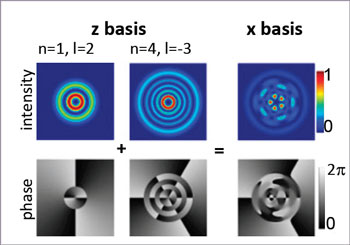In a recent PNAS paper, scientists have described how they managed to achieve a quantum entanglement with a minimum of 103 dimensions with only two particles.
103 dimensions rather than 3? Is that a typo?
Elementary particles such as photons can produce superpositions - where they exist in many possible quantum states simultaneously. In addition, when two particles are entangled a connection is generated so measuring the state of one (whether they are in one place or another, or spinning one way or another, for example) affects the state of the other particle instantly, no matter how far away from each other they are.
Scientists have spent years combining both properties to construct networks of entangled particles in a state of superposition. This allows constructing elementary quantum computers capable of operating at unimaginable speeds, encrypting information with total security and conducting experiments in quantum mechanics.
Until now, in order to increase the "computing" capacity of these particle systems, scientists have mainly turned to increasing the number of entangled particles, each of them in a two-dimensional state of superposition: a qubit (the quantum equivalent to an information bit, but with values which can be 1, 0 or an overlap of both values). Using this method, scientists managed to entangle up to 14 particles.

Credit: Universitat Autònoma de Barcelona
A research team directed by Anton Zeilinger and Mario Krenn from the Institute for Quantum Optics and Quantum Information of the Austrian Academy of Sciences managed to achieve a quantum entanglement with a minimum of 103 dimensions with only two particles.
"We have two Schrödinger cats which could be alive, dead, or in 101 other states simultaneously," joked contributor Marcus Huber of the Universitat Autonoma de Barcelona
Group of Quantum Information and Quantum Phenomena, "plus, they are entangled in such a way that what happens to one immediately affects the other."
The results implies a record in quantum entanglements of multiple dimensions with two particles, much higher than the 11 dimensions previously noted.
Instead of entangling many particles with a qubit of information each, the scientists generated one single pair of entangled photons in which each could be in more than one hundred states, or in any of the superpositions of theses states; something much easier than entangling many particles. These highly complex states correspond to different modes in which photons may find themselves in, with a distribution of their characteristic phase, angular momentum and intensity for each mode.
"This high dimension quantum entanglement offers great potential for quantum information applications. In cryptography, for example, our method would allow us to maintain the security of the information in realistic situations, with noise and interference. In addition, the discovery could facilitate the experimental development of quantum computers, since this would be an easier way of obtaining high dimensions of entanglement with few particles," explained Huber.
Now that the results demonstrate that obtaining high dimension entanglements is accessible, scientists conclude in the article that the next step will be to search how they can experimentally control these hundreds of spatial modes of the photons in order to conduct quantum computer operations.




Comments